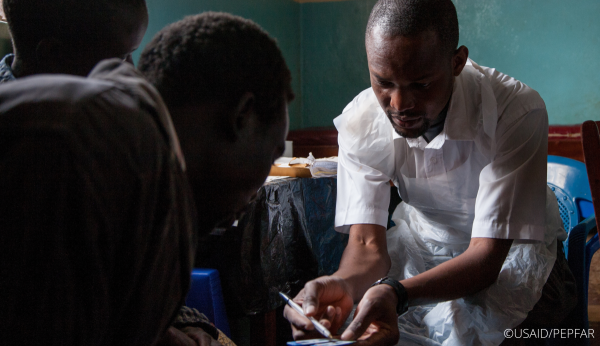You are here
Bringing together clinical and community partners for better health outcomes through PEPFAR

The social service workforce can play a unique and powerful role in supporting individuals and communities in addressing social determinants of health. However, for health systems to gain the most from the unique skills and competencies of social service workers, care must be taken in determining how these workers are deployed. The Global Social Service Workforce Alliance’s recent technical report, Social Service Workers in Health Facilities: Their Role in Addressing Social and Other Determinants of Health Among Children and Families, finds the most common models for deployment to include the roving or liaison model, the permanent on-site support model and the interprofessional team model. In lower-resource settings or where integration of social services into health is developing, a roving or liaison model with substantial time spent doing home visits may be the most appropriate. It has also been applied with support from donors seeking to strengthen linkages between clinics and communities within an existing health system but without making significant changes to staffing or infrastructure.
People-centered care has long been practiced within the U.S. President’s Emergency Plan for AIDS Relief’s (PEPFAR) Orphans and Vulnerable Children (OVC) programming. With an emphasis on wraparound services and close collaboration with partners operating in health facilities, PEPFAR OVC implementing partners have shown promising results integrating health and social services, and the workforces providing them, particularly using the roving/community liaison model.
In Eswatini, the Insika Project, led by Pact, leveraged existing cadres of home visitors already engaged in comprehensive case management for OVC to disseminate information on the COVID-19 vaccination, then liaise with vaccine mobilizers to register and follow up with children and caregivers over the two-dose series. Administered either at home by a visiting nurse or at a community site, 74 per cent of project beneficiaries offered the vaccine have now been vaccinated compared to 60 per cent of non-project beneficiaries in the same geographic areas. The highest-performing areas are where vaccine mobilizers are paired with nurses in roving teams. This success is attributed to stronger relationships, regular engagement, and the resulting rapport and trust between project beneficiaries and the home visitor connecting them to the health facility, creating increased demand for vaccines.
In Zambia, the Empowered Children and Adolescent Program 1, led by the Center for Infectious Disease Research in Zambia, and the SAFE Project, led by John Snow, Inc., developed an intensified approach to community viral load sample collection. Community case workers identify young people who have missed or are having difficulties making their appointments as part of their routine case management home visits. The community case workers are paired with facility case workers who verify the patients’ viral load status and facilitate access to testing provided on the weekends in nearby sites. This schedule is often preferred by adolescents who are either in school or uncomfortable waiting in long lines at health facilities. Viral load coverage at Nchanga North Referral Hospital, in the catchment area where this intensified approach has been deployed, has improved from 72 per cent in January 2021 to 97 per cent in March 2022.
In Zimbabwe, the Catholic Relief Services-led Pathways Project, in conjunction with the Ministry of Health and Child Care, trained 86 points of contact from among para professional social service cadres, like lead childcare workers, and stationed them at health facilities.
“Traditionally, in health facilities and for clinical workers, there has not been much space for social worker contributions…Slowly and progressively, we see some appreciation and acknowledgement of their role…People are beginning to find each other and appreciate that nobody is coming to intrude in each other’s space but to complement each other,” observed Richard Savo, Deputy Chief of Party for the project.
With agreements in place between the clinical and OVC implementing partners, and using a case management approach, these points of contact help children and families affected by HIV navigate needed services. They track them at the household level and monitor their risk of dropping out of treatment through close coordination with village health workers and community and childcare workers engaged by local implementing partners in nine districts. During COVID-19 shutdowns, the points of contact ensured multi-month supplies of medications were dispensed to HIV-positive patients to support adherence to treatment while regular health services were disrupted. Overall, the project has achieved a success rate of 95 per cent of HIV positive people who previously stopped taking their medication return to care.
For more information on the different models for deployment of social service workers in health facilities, read the full technical report: Social Service Workers in Health Facilities: Their Role in Addressing Social and Other Determinants of Health Among Children and Families.

